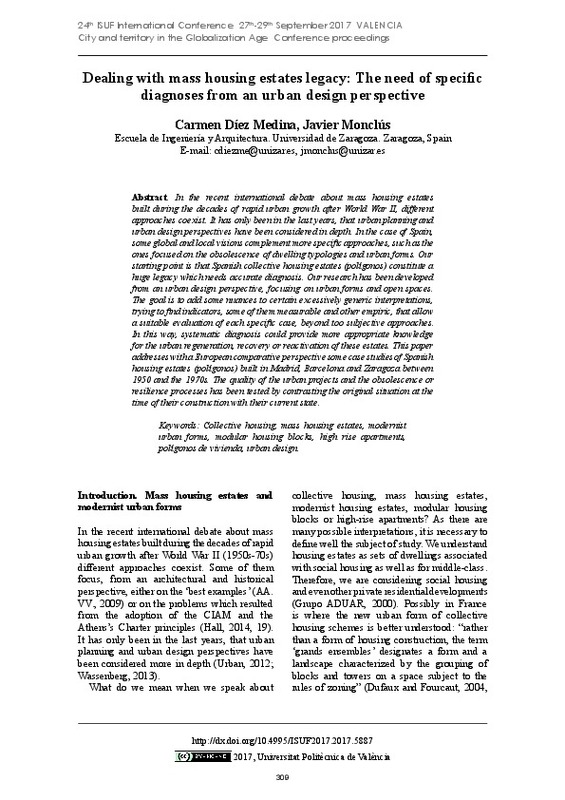JavaScript is disabled for your browser. Some features of this site may not work without it.
Buscar en RiuNet
Listar
Mi cuenta
Estadísticas
Ayuda RiuNet
Admin. UPV
Mass housing estates legacy: urban design perspectives
Mostrar el registro sencillo del ítem
Ficheros en el ítem
| dc.contributor.author | Díez Medina, Carmen
|
es_ES |
| dc.contributor.author | Monclús, Javier
|
es_ES |
| dc.coverage.spatial | east=-3.7037901999999576; north=40.4167754; name=Madrid, Espanya | es_ES |
| dc.coverage.spatial | east=2.1734034999999494; north=41.3850639; name= Barcelona, Espanya | es_ES |
| dc.coverage.spatial | east=-0.8890853000000334; north=41.64882259999999; name= Zaragoza, Espanya | es_ES |
| dc.date.accessioned | 2018-12-03T08:48:15Z | |
| dc.date.available | 2018-12-03T08:48:15Z | |
| dc.date.issued | 2018-04-20 | |
| dc.identifier.isbn | 9788490485743 | |
| dc.identifier.uri | http://hdl.handle.net/10251/113419 | |
| dc.description.abstract | [EN] In the recent international debate about mass housing estates built during the decades of rapid urban growth after World War II, different approaches coexist. It has only been in the last years, that urban planning and urban design perspectives have been considered in depth. In the case of Spain, some global and local visions complement more specific approaches, such as the ones focused on the obsolescence of dwelling typologies and urban forms. Our starting point is that Spanish collective housing estates (polígonos) constitute a huge legacy which needs accurate diagnosis. Our research has been developed from an urban design perspective, focusing on urban forms and open spaces. The goal is to add some nuances to certain excessively generic interpretations, trying to find indicatosrs, some of them measurable and other empiric, that allow a suitable evaluation of each specific case, beyond too subjective approaches. In this way, systematic diagnosis could provide more appropriate knowledge for the urban regeneration, recovery or reactivation of these estates. This paper addresses with a European comparative perspective some case studies of Spanish housing estates (polígonos) built in Madrid, Barcelona and Zaragoza between 1950 and 1970s. The quality of the urban projects and the obsolescence or resilience processes has been tested by contrasting the original situation at the time of their construction with their current state | es_ES |
| dc.format.extent | 14 | es_ES |
| dc.language | Inglés | es_ES |
| dc.publisher | Editorial Universitat Politècnica de València | es_ES |
| dc.relation.ispartof | 24th ISUF International Conference. Book of Papers | es_ES |
| dc.rights | Reconocimiento - No comercial - Sin obra derivada (by-nc-nd) | es_ES |
| dc.subject | Collective housing | es_ES |
| dc.subject | Mass housing states | es_ES |
| dc.subject | Modernist urban forms | es_ES |
| dc.subject | Modular housing blocks | es_ES |
| dc.subject | High rise apartments | es_ES |
| dc.subject | Polígonos de vivienda | es_ES |
| dc.subject | Urban design | es_ES |
| dc.title | Mass housing estates legacy: urban design perspectives | es_ES |
| dc.type | Capítulo de libro | es_ES |
| dc.type | Comunicación en congreso | es_ES |
| dc.identifier.doi | 10.4995/ISUF2017.2017.5887 | |
| dc.rights.accessRights | Abierto | es_ES |
| dc.description.bibliographicCitation | Díez Medina, C.; Monclús, J. (2018). Mass housing estates legacy: urban design perspectives. En 24th ISUF International Conference. Book of Papers. Editorial Universitat Politècnica de València. 309-322. https://doi.org/10.4995/ISUF2017.2017.5887 | es_ES |
| dc.description.accrualMethod | OCS | es_ES |
| dc.relation.conferencename | 24th ISUF 2017 - City and Territory in the Globalization Age | es_ES |
| dc.relation.conferencedate | Septiembre 27-29,2017 | es_ES |
| dc.relation.conferenceplace | Valencia, Spain | es_ES |
| dc.relation.publisherversion | http://ocs.editorial.upv.es/index.php/ISUF/ISUF2017/paper/view/5887 | es_ES |
| dc.description.upvformatpinicio | 309 | es_ES |
| dc.description.upvformatpfin | 322 | es_ES |
| dc.type.version | info:eu-repo/semantics/publishedVersion | es_ES |
| dc.relation.pasarela | OCS\5887 | es_ES |








